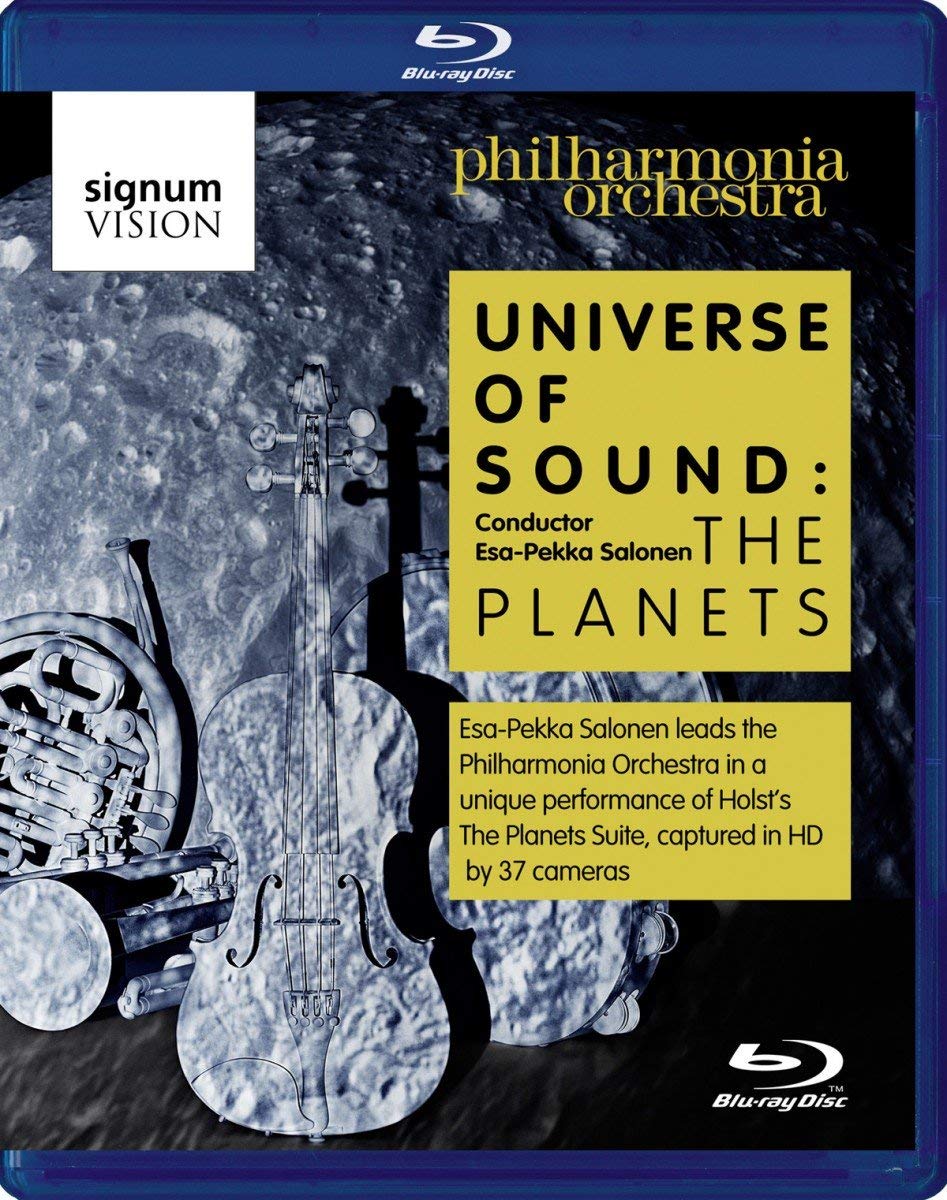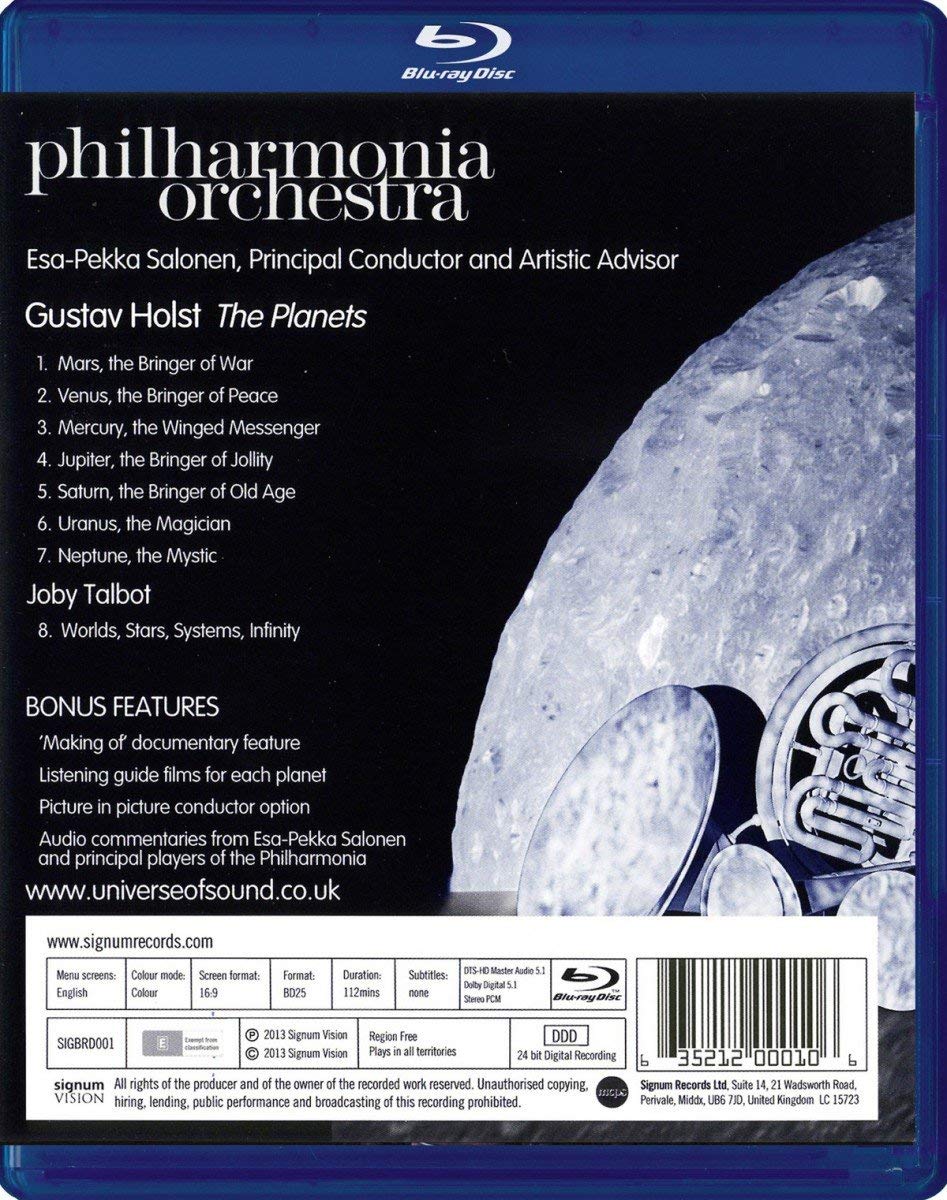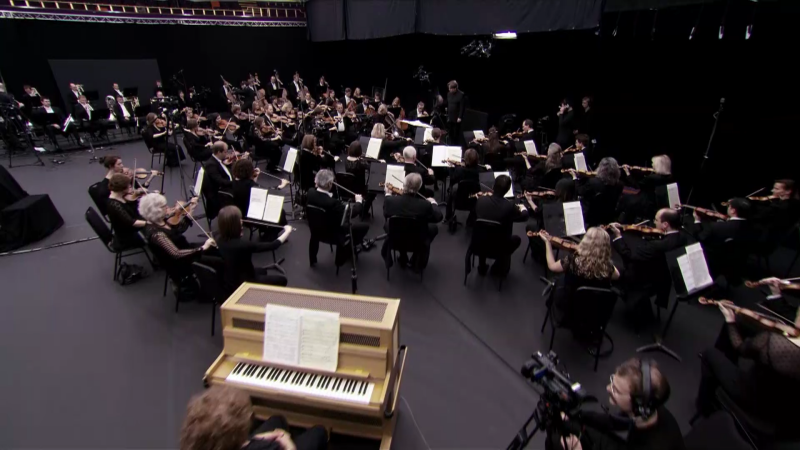

Universe of Sound documentary about a special performance of the Holst The Planets and Joby Talbot's Worlds, Stars, Systems, Infinity. Esa-Pekka Salonen conducts the Philharmonia Orchestra. This is the first HDVD from the Signum label (or is it Signum Vision?). Released 2013, disc has 5.1 dts-HD Master Audio sound. Grade: B as a documentary only. (As a concert disc, the grade would be "F".)
What in the universe is going on here? Here are slightly edited portions of a press release I got from about this title shortly before it was released:
“This title arose out of a major ‘virtual orchestra’ digital installation project that the Philharmonia Orchestra and Esa-Pekka Salonen undertook in the summer of 2012 at London's Science Museum. The installation allows visitors to walk through a symphony orchestra while it performs Holst's The Planets, and involves large screen projections of principal musicians and each section of the orchestra, together with interactive content such as a conductor simulator, live percussion demonstrations, and being able to listen to commentaries from the musicians and Salonen as they perform the music. The content for the installation was shot using 37 cameras."
Whew! Why would you do this in a science museum? Answer: Because kids love science museums and hate symphony orchestras. And what does this mean to us? Well, we now can buy a strange documentary about a virtual orchestra digital installation project with an even stranger performance of The Planets thrown in plus about 8 minutes of new music from Joby Talbot.
Let me explain by first listing the items in the rather complicated and tricky menu on this disc:
Play Feature Has a performance of The Planets in 7 movements + the Talbot music. I'll call this The Planets +
The Planets This menu item lets you pick out a specific movement from the above. For example, you can call up the "Saturn" track without playing the whole suite
Audio Set Up
You can select LPCM stereo, dts-DH Master Audio, or Dolby Digital sound
In addition, while you play the performance, you can call up a running commentary on The Planets + by Esa-Pekka Salonen and Richard Slanty
As a separate additional option, you can hear running comments from five musician while you play the performance
Picture Set Up
Of course you can watch a normal simple picture
An option is to see a small PIP view of the conductor leading the orchestra
Another option is to see the screen split into 5 sections with video and running comments from five principal musicians
Special Features
A speaker discusses in a series of "Listening Guides" some of the musical characteristics of each movement of The Planets +
"Universe of Sound—The Planets." This shows you what the virtual orchestra digital installation project looked like at the science museum and how the project got made
Strangely, the further down the menu you go, the more interesting the segment is. So lets start at the bottom and work our way up.
Special Feature: "Universe of Sound—The Planets." To make the installation, the orchestra was "exploded" in a huge recording studio into separate sections divided by wide pathways and, sometimes, black curtains. Although there were 37 HD cameras deployed, no camera could see the whole orchestra. The reason for exploding the band was to allow each section to be recorded alone while playing. The section members could not hear the other musicians in the normal way, but everyone got some view of the conductor. (Well, the organ and the female chorus were recorded in completely different locations and spliced in later.)
Because of all the cameras and lights, it was hot in the studio. Everybody dressed formal. Because the orchestra was playing in such an unnatural configuration, it took as many as 20 takes of some of the music to get everybody properly coordinated. All the while an army of cameramen were crawling around shooting. One violin player had a camera mounted on his head. A small camera was mounted on the end of a trombone slide! Don't pick your nose! The shoot lasted 2 days and must have been an exhausting experience for everyone.
There were 45 mikes for sound recording. The cameramen continued to record the post-performance process of editing the raw video footage and 45 sound streams into a performance and combining it with the numerous interactive parts of the exhibition.
Finally, camera crews tracked several weeks of sophisticated set up of all the gear in the science building. The installation occupied a number of rooms in the Science Museum. Visitors would see different sections of the orchestra in isolation in different rooms. For example, the 7 horn players would be seen playing in a row by themselves on one wall and maybe the trombones would be seen on another wall in the same room. I think different areas in the installation may have been themed for each of the planets. Finally, there was a nice cocktail party for the suits and skirts behind all of this. I know there's a lot involved after the curtain call in making any kind of audio-visual presentation for the consumer. This part of subject title is the best bonus I've seen to show a bit of post-production process.
Special Feature: "Listening Guides" There is a guide for each movement in The Planets. They are presented by the same speaker and are reasonably interesting. But there are two problems. First, there are no subtitles in English or other languages. I had trouble understanding the speaker with his British accent. Second, each of the guides is a separate title with its own introduction and conclusion with credits to sponsors and the like. Perhaps there was a different area at the installation for each planet with a discrete guide for music related to that planet. But it is not pleasant or efficient to view the separate guides one after the other. It would have been better to edit the material into a single presentation for home theater viewing.
Picture Set Up—PIP of Conductor. With this turned on, you can watch the whole performance with an extra view of Salonen in a small corner picture. This is an excellent feature executed well, but who would want to see this other than a student conductor?
Picture Set Up—Multiview with Principal Players. With this turned on, you see a principal horn, bassoon, trumpet, violin, and tympani player performing all the way through The Planets in 5 different sections of the screen. You then hear voice-over chatting from each player revealing their thoughts while playing and their assessments of the recording after the fact. This feature has subtitles in English that are color-coded to show you who is talking. I think this segment is handed about as well as possible and is quite interesting.
Audio Set Up—Running Commentary by Esa-Pekka Salonen and Richard Slanty. With this running, you see the concert and hear Salonen and Slanty discuss it. The problem here is that neither of these gents is a professional announcer and both have accents speaking English. There are no subtitles. So I found the strain of trying to understand them made this option too wearisome for me.
Audio Set Up—Running Commentary by Principal Musicians. This is the voice part of the multiview feature I praised above. Without the pictures of the musicians and the subtitles to help out, I found the voice part alone hard to follow.
Play Feature. Now finally we will discuss the actual performance of The Planets +. What you see as the main event on this disc is the video of the performance of the exploded orchestra. This performance was maybe a brilliant success for the special purpose intended for the film. But offering this to be shown in a home theater is problematical.
The sound quality, while adequate for use in a noisy museum with kids running around, is not impressive to me. There are many instances where instruments being photographed can hardly be heard. For example there are two prominent cuts in the "Mars" movement with a percussionist playing hard on a snare drum, but you don't hear the drum at all. The harps are especially poorly recorded, and there are several shots of the double bass section with little sound of the instruments. When the brass sections are invoked, you can hear them for sure, but other instruments may be covered over. Likewise, the picture quality, while fine for the museum screens, is soft by our standards.
But the real problem is the picture content. I don't question the wisdom of making a film of an exploded orchestra so as to introduce the various sections to children. But this way of photographing the orchestra is not acceptable under our standards for making a video for enjoyment in a home theater of a symphony orchestra.
The basic problem is that we want to use the power of HD TV to make it possible to see the whole orchestra much of the time when playing at the symphony level. For this the TV director might need 3 to 7 cameras. But the Universe of Sound approach is the complete opposite. 37 cameras are used to atomize the orchestra in a configuration where there is no possibility of making even a single frame of the whole orchestra.
If you are having trouble following all this, maybe a few screenshots will help. First I'll show 4 shots to give you some idea of what the museum installation looked before the museum visitors started swarming through the exhibits:
In the museum exhibition, the visitor could see the whole orchestra spread out over three screens in panoramic display:
But I don't know of anybody with a home theater with 3 screens. The best that could be done with a single camera for home viewing is the shot below, which is missing the harps, the percussion, the flutes, all the reeds, and the horns. There is no possibility of shooting the whole orchestra from behind the conductor because the conductor has a wall behind his back! This has got to be the strangest video presentation of a symphony orchestra in the history of fine-art video:
Most of the film for home viewing consists of isolated soloists and small sections:
Let's don't forget that wonderful chorus part Holst wrote for the final movement. Well, that music was dubbed in after being recorded at a church:
From our perspective, offering The Planets + for home theater viewing would be insane. But I don't think the full performance on this disc is offered to the consumer in the same way as all our other symphony titles are. In the March 2013 Gramophone (at page 19) music director Salonen is quoted as saying, "I don't think the aim of a production like this should be that of emulating a live performance. It's something totally different, something that will give you an insight into the inner workings of an orchestra." Here I agree with Salonen: subject title is just a documentary about the sections of an orchestra and not intended to be enjoyed as an actual performance.
I therefore reach the conclusion that subject title can be graded B as a documentary only. The only grade I could have given to the concert part of subject title would be F, but Salonen himself has taken me off the hook on that.
Final observations: I do think that Signum Vision is offering this title as an actual performance in an effort to sell it and that this is misleading or even false advertising. But nobody with the slightest experience expects accuracy or honestly in advertising or packaging from the record publishing industry. To get at the truth, you have to consult critics who are willing to tell the truth about what they see. So, be wary of this disc unless you are a serious student musician and/or conductor or otherwise get interested in this as a documentary. For most folks, this disc would be a very poor value.
I still hope one day to see a performance of The Planets properly presented. But even thought I was sorely disappointed with this title, I'm still glad I have it. I did learn interesting facts about the The Planets. This title proves how effective the "Picture Set Up—Multiview with Principal Players" feature can be. This technique could be used as a bonus with any recording of classical music if the producer could budget for the locked-down cameras needed and the post-production costs.
Here’s a clip from the Philharmonia Orchestra:
OR













